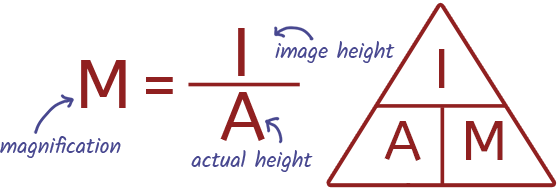
Light
Light is a form of electromagnetic radiation that our eyes can detect, allowing us to see objects. It travels in straight lines and can be reflected, refracted, or absorbed by different materials. Convex lenses converge light rays to a focal point, useful in magnifying glasses and cameras, while concave lenses diverge light, helpful in correcting vision problems like near-sightedness.
Equations on this page:
Magnification
Practials on this page:
Refraction of Light
What are Convex and Convave lenses?
A convex lens is thicker in the middle and thinner at the edges, resembling a bulging shape. It converges light rays towards a focal point on the opposite side of the lens. Convex lenses are commonly used in magnifying glasses, cameras, telescopes, and eyeglasses for correcting farsightedness.
A concave lens is thinner in the middle and thicker at the edges, resembling a hollowed-out shape. It diverges light rays, causing them to spread out. Concave lenses are used in devices such as eyeglasses for correcting nearsightedness and in optical instruments like microscopes and projectors.
How do lenses produce images?
When light passes through a lens, it bends or refracts due to differences in the density of the lens material compared to the surrounding air. This bending of light rays is known as refraction. Lenses can be of two types: convex and concave.
Convex lenses are thicker in the middle and thinner at the edges, resembling a bulging shape. When parallel light rays pass through a convex lens, they converge or come together at a point on the opposite side of the lens called the focal point. If an object is placed beyond the focal point of a convex lens, a real inverted image is formed on the opposite side of the lens. However, if the object is placed closer to the lens than the focal point, a virtual upright image is formed on the same side as the object.
Concave lenses, on the other hand, are thinner in the middle and thicker at the edges, resembling a hollowed-out shape. When parallel light rays pass through a concave lens, they diverge or spread out. As a result, a virtual upright image is formed on the same side as the object, and the image appears smaller than the object itself.
The type of image formed (real or virtual, inverted or upright, magnified or diminished) depends on the position of the object relative to the focal point and the type of lens used. Real images are formed when light rays actually converge at a point, while virtual images are formed when light rays appear to diverge from a point. The size and position of the image also depend on the distance of the object from the lens and the focal length of the lens.
Knowing these principles helps understand how lenses produce images and how optical devices like cameras, microscopes, and telescopes utilize these properties to create clear and magnified images.
What is a ray diagram?
A ray diagram is a simple visual representation used in optics to illustrate how light behaves as it interacts with lenses, mirrors, or other optical devices. It's a way to track the paths of light rays and determine where they converge or diverge to form images. Ray diagrams are essential tools for understanding how light behaves in optical systems and for predicting the characteristics of images formed by lenses and mirrors.
What is visible light?
Visible light is a form of electromagnetic radiation that is visible to the human eye. It's just one part of the electromagnetic spectrum, which includes other types of radiation like radio waves, microwaves, infrared, ultraviolet, X-rays, and gamma rays.
Visible light has wavelengths ranging from approximately 400 to 700 nanometers (nm). These wavelengths determine the colour of the light. The different colours of visible light include red, orange, yellow, green, blue, indigo, and violet, arranged in order of increasing wavelength and decreasing frequency. White light is a mixture of all the colours of the visible spectrum, while black is the absence of visible light.
Key Words
Axis - a line passing through the middle of the lens.
Magnifying glass - creates a magnified virtual image.
Opaque - objects that do not transmit light. They absorb some wavelengths and reflect others.
Transparent/translucent - transmit light. Some wavelengths pass through.
Colour filters - only let through particular wavelengths.
Also see Waves, Electromagnetic Waves
EQUATION Magnification
Magnification is how much bigger or smaller an object appears when you look at it through a lens or a microscope compared to its actual size.

PRACTICAL Refraction of Light
Watch the video and have a go at writing out the steps of the practical.




